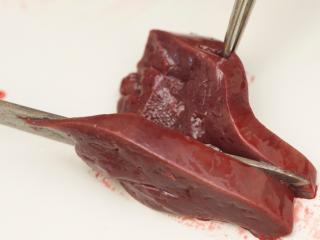Lesion samples
- Sample the lesion and describe its gross appearance and extent (size or % of organ affected).
- Maximum sample width = 8mm (except for brain – see below).
- Fixation of 8mm slices takes about 24 hours:
- large sections delay fixing, promote autolysis and decrease formalin volume
- the largest tissue section on a slide is 20x30mm so larger specimens are wasted
- Consider multiple sections if multiple or large lesions need examination.
- Ensure samples are representative of lesions. For large lesions:
- sample the interface with normal tissue and
- areas of different colour or consistency.
- Ensure samples are representative of tissue (some organs have different functional areas):
- kidney has cortex, medulla and pelvis; heart has left and right ventricles, inter-ventricular septum, valves, atria etc.
- Cover multiple diagnostic options (gains background data for your client’s properties).

Sample thickness: Solid tissues should be a maximum of 8mm thick (except the brain) to optimise formalin fixation.
Fixing samples in formalin
- Use 10 times as much 10% buffered formalin as tissue.
- Warming increases fixation rate – and fumes. Ventilate area well and seal jars.
- Fixed tissues expand. Avoid narrow-necked jars as tissue cannot always be safely removed.
- Fixed tissues can be drained before transporting to the laboratory. Seal well and add a few millilitres of formalin to moisten tissue.
- For transport, pool fixed tissues in reduced volumes of 10% buffered formalin unless samples cannot be distinguished from one another or are diagnostically relevant (e.g. multiple lymph nodes from different sites need to be individually identified).
Brain
- Remove the whole brain – different sites are examined for different diseases. See the Brain removal techniques guide.
- Use swabs of the brain and/or meninges or a small section of frontal lobe/cervical spine for culture, then fix the whole brain. The brain fixes whole but takes 3–4 days.
- Rabies and organophosphate testing need fresh, chilled, half a sagittally sectioned brain.
Other organs
- Hepatic blood flow is not homogeneous. If no gross lesion, sample left and right lobes.
- Pulmonary air flow is not homogeneous. If no gross lesion, sample cranio-ventral and dorso-caudal areas.
- Intestinal sections should be 25mm long, unopened with a 5mm nick in each end to allow optimal formalin penetration without damaging mucosal surfaces.
- Do not scrape, wipe or mush mucosal surfaces and tissues that you want examined
- Sample multiple muscles for nutritional myopathy. Most consistently affected are semitendinosous, semimembranous and lateral and medial vastus.
- If sending whole or live animals, call the DPIRD Diagnostic Laboratory Services (DDLS) pathologist before submission.

Fixing the intestine: Short (25mm) gut sections with nicks in the end encourage the intestine to fix dilated rather than collapsed, improving mucosal preservation. Do not scrape the mucosa of sections for histopathology or the epithelium will be lost.
More information
- DPIRD Diagnostic Laboratory Services – Animal Pathology: DDLS@dpird.wa.gov.au or duty pathologist +61 (0)8 9368 3351
- Your local Department vet: see Livestock Biosecurity veterinary contacts
- Other guides to assist veterinarians in conducting post-mortems: Veterinary sampling and post-mortem resources page
- After hours emergency animal disease hotline: 1800 675 888
